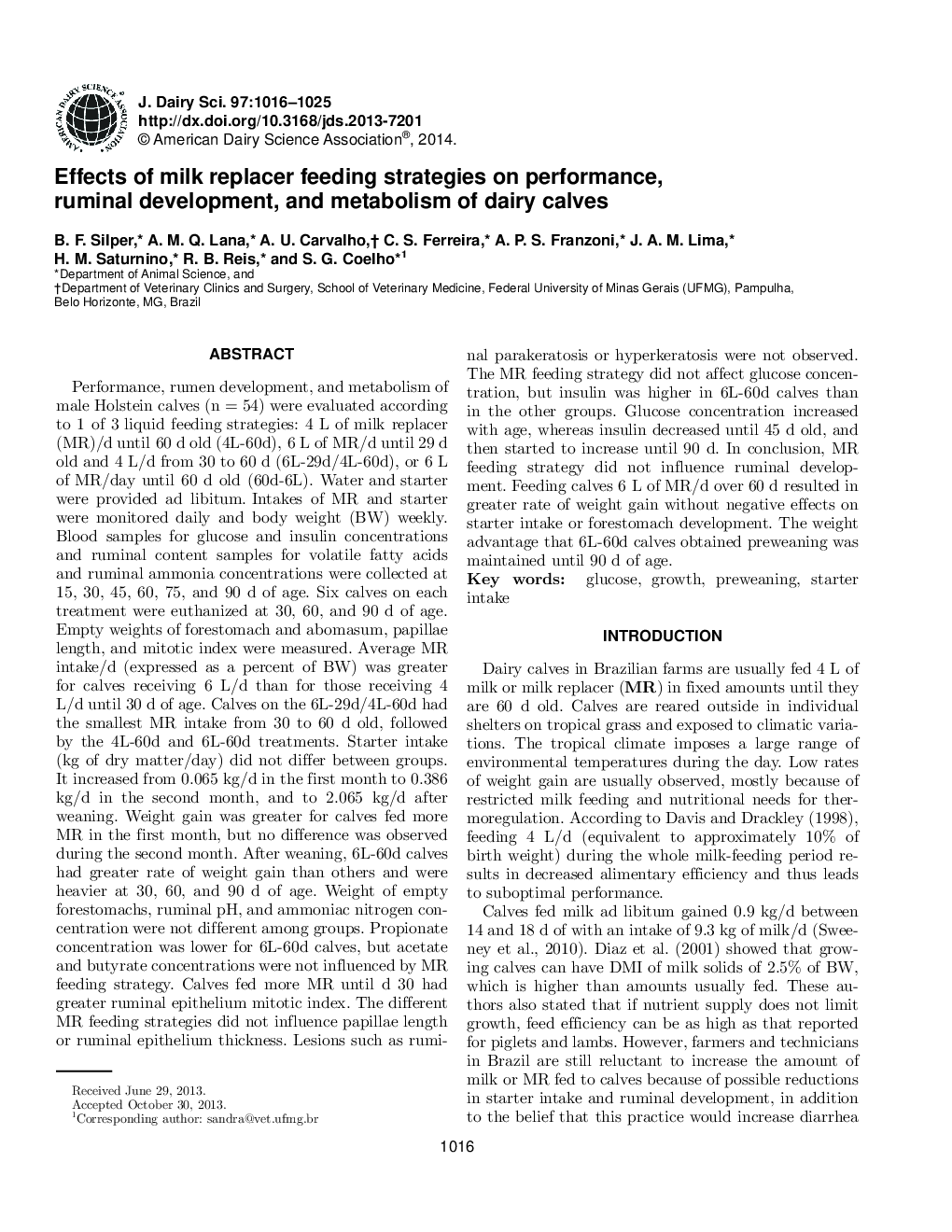| کد مقاله | کد نشریه | سال انتشار | مقاله انگلیسی | نسخه تمام متن |
|---|---|---|---|---|
| 10977061 | 1108046 | 2014 | 10 صفحه PDF | دانلود رایگان |
عنوان انگلیسی مقاله ISI
Effects of milk replacer feeding strategies on performance, ruminal development, and metabolism of dairy calves
ترجمه فارسی عنوان
اثرات استراتژی تغذیه جایگزین شیر بر عملکرد، رشد شکم و متابولیسم گوساله های شیری
دانلود مقاله + سفارش ترجمه
دانلود مقاله ISI انگلیسی
رایگان برای ایرانیان
کلمات کلیدی
گلوکز، رشد، پیش داوری مصرف استارت،
موضوعات مرتبط
علوم زیستی و بیوفناوری
علوم کشاورزی و بیولوژیک
علوم دامی و جانورشناسی
چکیده انگلیسی
Performance, rumen development, and metabolism of male Holstein calves (n = 54) were evaluated according to 1 of 3 liquid feeding strategies: 4 L of milk replacer (MR)/d until 60 d old (4L-60d), 6 L of MR/d until 29 d old and 4 L/d from 30 to 60 d (6L-29d/4L-60d), or 6 L of MR/day until 60 d old (60d-6L). Water and starter were provided ad libitum. Intakes of MR and starter were monitored daily and body weight (BW) weekly. Blood samples for glucose and insulin concentrations and ruminal content samples for volatile fatty acids and ruminal ammonia concentrations were collected at 15, 30, 45, 60, 75, and 90 d of age. Six calves on each treatment were euthanized at 30, 60, and 90 d of age. Empty weights of forestomach and abomasum, papillae length, and mitotic index were measured. Average MR intake/d (expressed as a percent of BW) was greater for calves receiving 6 L/d than for those receiving 4 L/d until 30 d of age. Calves on the 6L-29d/4L-60d had the smallest MR intake from 30 to 60 d old, followed by the 4L-60d and 6L-60d treatments. Starter intake (kg of dry matter/day) did not differ between groups. It increased from 0.065 kg/d in the first month to 0.386 kg/d in the second month, and to 2.065 kg/d after weaning. Weight gain was greater for calves fed more MR in the first month, but no difference was observed during the second month. After weaning, 6L-60d calves had greater rate of weight gain than others and were heavier at 30, 60, and 90 d of age. Weight of empty forestomachs, ruminal pH, and ammoniac nitrogen concentration were not different among groups. Propionate concentration was lower for 6L-60d calves, but acetate and butyrate concentrations were not influenced by MR feeding strategy. Calves fed more MR until d 30 had greater ruminal epithelium mitotic index. The different MR feeding strategies did not influence papillae length or ruminal epithelium thickness. Lesions such as ruminal parakeratosis or hyperkeratosis were not observed. The MR feeding strategy did not affect glucose concentration, but insulin was higher in 6L-60d calves than in the other groups. Glucose concentration increased with age, whereas insulin decreased until 45 d old, and then started to increase until 90 d. In conclusion, MR feeding strategy did not influence ruminal development. Feeding calves 6 L of MR/d over 60 d resulted in greater rate of weight gain without negative effects on starter intake or forestomach development. The weight advantage that 6L-60d calves obtained preweaning was maintained until 90 d of age.
ناشر
Database: Elsevier - ScienceDirect (ساینس دایرکت)
Journal: Journal of Dairy Science - Volume 97, Issue 2, February 2014, Pages 1016-1025
Journal: Journal of Dairy Science - Volume 97, Issue 2, February 2014, Pages 1016-1025
نویسندگان
B.F. Silper, A.M.Q. Lana, A.U. Carvalho, C.S. Ferreira, A.P.S. Franzoni, J.A.M. Lima, H.M. Saturnino, R.B. Reis, S.G. Coelho,
